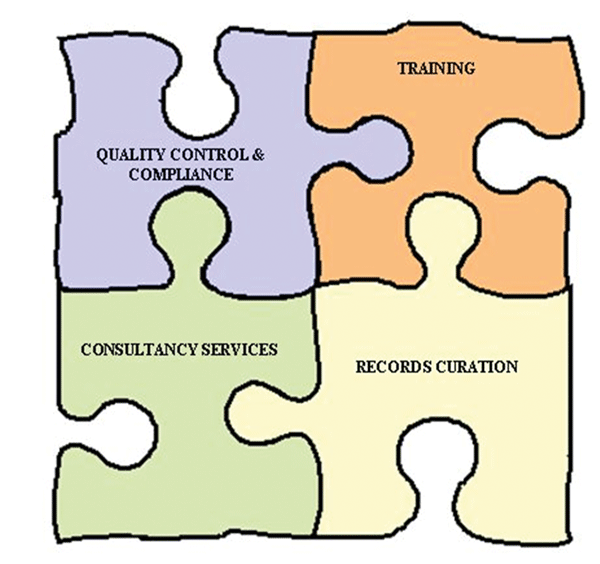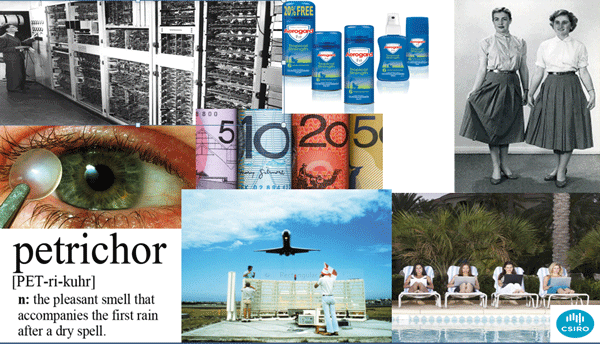Reinventing records management at the CSIRO

In 2015 what does an operational records management service look like? In the past it was a much easier task to imagine a records management operation. Crusty records officers located in a registry office, a great big compactus with lots of hardcopy files, a mysterious classification scheme, and the magical skill to find that obscure document when the CEO wanted it. We all know that those days are well and truly past, but what has replaced it and what works best in modern organisations?
CSIRO, the Commonwealth Scientific and Industrial Research Organisation, is Australia's national science agency and one of the largest and most diverse research agencies in the world. In 2011 CSIRO realised that modern work practices and records management demands required a rethink of our approach to Records Management and how records management services were delivered within a large national organisation.
Since 2012 records management operations have been completely re-engineered. Using an evidence based approach, supported by standards, a new model for records management service delivery has been developed and implemented, allowing limited records management resources to have the greatest impact for the organisation.
Until recently CSIRO lacked a single corporate records management service. Records Management operations were largely devolved and associated with specific business units and divisions. There was a loose coalition within the records management community in CSIRO, however when “push came to shove” independence was generally always asserted.
The journey towards a truly corporate records management service for CSIRO has been an interesting one, mistakes were made, tough decisions had to be taken and opportunities were uncovered.
This article will outline the bumpy ride towards achieving a new records management service for CSIRO. The implementation of an EDRMS within an organisation is not something to be taken lightly. The challenges faced can include technological challenges, change management challenges, project management challenges, financial challenges and political challenges.

Tim O’Grady, CSIRO Records Services Manager
Organisational structure
I would like to add another challenge to the list. How we structure our record management services is critical to the overall performance or success of a records management service. I would also argue that without a suitable Records Service structure the implementation of an EDRMS or other significant change management process is possibly doomed to failure.
CSIRO has an organisational history built around Scientific Divisions. These divisions were essentially groupings of particular expertise e.g. Engineers, Chemists, Meteorologists, etc. Divisions within CSIRO were semi-independent self-contained organisational units reporting to a central authority (Head Office). Each division generally had its own structure and staff, laboratories and buildings.
Each division was led by a Chief. This structure persevered until fairly recent times and has only recently been replaced by a more unified organisational model.
The implication for Records Services in CSIRO was that there were as many Records Operations as there were divisions in the organisation. In fact in a previous life I was responsible for issuing software licences for our EDRMS, TRIM, within CSIRO and at one stage we had 22 individual implementations of TRIM.
Some divisions did not have a formal records management operation, whilst those that did ranged from part-time services to mid-range operations with 3- 4 full-time staff. In the mid-1990s a loose coalition or network of records management staff developed with the aim of improving the standard of records management in CSIRO. This network was voluntary and generally whenever independence was threatened there was a breakdown in the network. In more recent times support services such as HR, Finance, IT and Records Management have been removed from the responsibility of divisions and support services have been delivered corporately. Records Management was established as an enterprise service in 2005 and has undergone a number of restructures until the present day.
In 2010 I was given the opportunity to lead RM Services within CSIRO. At that time we had approximately 28 staff spread across all states and territories, with the exception of the Northern Territory. Our structure for delivering services to CSIRO was built around 3 geographic regions:
- • Northern Region – NSW & Qld
- • Southern Region – VIC, SA and Tas, NT
- • Central West Region – ACT and WA
Whilst this structure did break down the old divisional control of records management services it did give rise to the development of 3 separate Records Management operations. Providing a consistent service to the organisation within this structure was a challenge. The range of products and services provided within each region were different and as a result Records Management service quality was not consistent across CSIRO. My view was that the organisation needed a records management service that provided a discrete set of products that could be delivered consistently regardless of location. So our journey began to find a structure that enabled us to achieve this outcome.
I think it is unlikely that a perfect model exists for records management services. Organisations are so very different, whether it be in terms of size; industry type; or sector (private / government).
Records Management operations are also very different in terms of size ranging from very small 1 -2 staff to very large 30 – 50 staff. They also vary in the type and range of services provided, particularly where hard copy records are still the primary method of record-keeping as distinct from those organisations operating within an electronic record-keeping environment.
In my view there isn’t a model that best suits most organisations, there are too many variables that make this impossible. However I believe there are some basic steps that can be used to assess if your current model is suitable and give you an idea of what changes might be necessary to put in place a model that works for your organisation.
So what are the key ingredients for successful Record Management Service?
In many organisations I have worked for in the past “Records Management” is seen as a mysterious practice. Perhaps more art than a science. As the manager of a records service I felt it was an impossible task to manage something that I couldn’t’ easily define. I needed some boundaries. I needed to know what is was we did and more importantly, what we didn’t do.
A colleague of mine at CSIRO once said to me “The problem with Records Management in CSIRO is that we make it up as we go along.” What was implied by this statement was that in CSIRO the approach to any records management challenge was to develop a bespoke solution. On a positive note this could be viewed as a client centric or agile approach, however from a management perspective it was a nightmare, with many varied approaches to records management existing at the same time. One of the problems leading to this was there had been no standards to guide Records Managers in CSIRO and no shared understanding of what it was that we did.
One of the first activities we undertook was to draw some boundaries around what the Records Group did in CSIRO. To that end a very basic model was developed. Called the Records Services Model it was the first attempt to define what services we provided to the organisation.

The Records Service Model
Using a jigsaw as a metaphor (see diagram above) helped sell this concept within the Records Services team e.g. putting the jigsaw pieces together so to speak. A pretty simple approach but it got people talking and thinking about what we did.
Some of the naming used in hindsight is a little clunky; however just getting the team to use common language like “Records Curation” was a big step forward.
Once we knew more about what we did, we started assessing to what extent we could provide these services within the resources we had at our disposal. Like most commonwealth government agencies increasing resources was not an option, in fact as we would find out in 2012 a reduction in resources was likelier.
One of our key findings was that it was not possible to provide a full service to the entire organisation. We had to work smarter and somehow we had to develop a model that ensured CSIRO met its records management obligations with the limited resources it had at its disposal. In an attempt to prioritise the work we had to deal with, we developed a Risk Management Framework for Record-keeping. This framework is a common-sense approach to making sure you maximise your resources to deal with the most important work.
As a result CSIRO has adopted a risk and value-based approach to the management of CSIRO Records in its Records Management policies. This approach categorises records on a scale of importance or risk and determines the level of management required. The model was developed using a risk management approach to record-keeping, acknowledging that Records Services should focus resources on the management of those records which are most important to CSIRO.
The colour coding of the risk categories (above) into red for high risk, yellow for moderate risk and green for low risk introduced some new language into the CSIRO Records Management lexicon “Red Zone Records” meaning important or high risk records. The development of the risk framework and the associated treatment methods for records within each category was a revolution in CSIRO records services and our clients. The pieces were starting to come together. We had the makings proper business model. Next we needed a structure to enable us to best deliver our services.
Finding the Correct Fit
With the greater clarity provided by our Records Services Model about the services we provided the organisation and a strategy to deliver those services within our current resources through our Risk Management Framework we could now start to build a structure that would deliver the services in an effective way.
It would be unfair to characterise the change process outlined so far as a linear progression for Records Services in CSIRO. It was more an evolution of ideas and then building on those ideas. There was never a clear mandate given to me or anyone else up to this point to develop the Records Services Model or the Risk Management Framework. They developed through discussions, disagreements and reflection. In some ways their origin lies in trying to find solutions to problems we encountered in the delivery of Records Services to CSIRO over a number of years.
This slow evolution of ideas came to an abrupt end during 2012 and a revolution commenced. At this time an organisational restructure saw records services lose some 6 FTE positions out of a total of28. A radical rethink of our structure was required and thankfully some of the work we had undertaken over the past few years informed us on how best to meet these challenges.
The end result was a move away from a geographical structure for records services to what in CSIRO is referred to as an Enterprise Model. Rather than dividing the team into separate cells to provide services to a limited group of clients, we formed a single group providing services to the whole organisation. The principle underpinning the design was “Records Services anytime and place”. There is nothing original in the design we developed. I admit that I looked more to the corporate world to provide examples rather than the government sector on which to base our design. My objective was to turn records services into a “Business” with products we could market to our clients. It would be nice to think at some point we could sell these services, but at this point this would be a very big challenge and may be beyond my capabilities.
The structure we implemented has divided the Records Services staff into 3 teams:
- Business Partners – our consultancy service, providing advice and training to CSIRO business units. This group also has responsibility for procedure development.
- Client Support - Our first point of contact. Responsible for the delivery of routine service products and referral of requests to other RS teams.
- Collection Services – Responsible for the management of our considerable hard copy collections (approximately 20 km)
Sometimes it takes an external event like a restructure to create a step change to operations. We all knew where we were heading but there was no imperative driving to get there. The restructure created that sense of urgency required.
As a footnote to this restructure I should make a few observations:
- From the time we announced our intention to move to a new structure and forming teams was about 4 months.
- Some very difficult decisions were taken with regard to staff reductions.
- I cannot overestimate the need to treat team members with respect during a restructure process.
- Whilst in the longer term the result has been a good outcome for Records Services in CSIRO it did have a profound impact on staff working in the team. Both those remaining and those that were made redundant.
The structure of our teams was only part of the story, some additional ingredients were required to make our new service successful.
CSIRO is lucky to have excellent IT infrastructure and Records Services takes full advantage of the tools available to us to support our clients. Clients can contact us online no matter where they are located using a request management tool called ServiceLINK . This tool enables clients to access specific products such as training, request the registration of a file or contact us with a general query.
Virtual training sessions can be convened for staff located across the country using desktop video conferencing software called MeetingPlace and real time support can be provided using the same tool to remote into clients PCs to install and configure software or troubleshoot problems.
We provide online documentation via our intranet site to assist clients with record-keeping and we have a single phone contact number the “Records Hotline” for urgent contact, or those not able to access our online requests tools.
It is important to note that whilst we have modernised the way we deliver our services and communicate with our clients, we still maintain a physical presence on most of the major site locations in Australia and when required we can still send a real person to help out. To that end the structure we have implemented was guided by the availability of tools that could make it happen. Without these tools I believe our structure would be quite different. In that sense I know we are very lucky to work in an organisation that is well supported with IT infrastructure
Success or Failure?
The new structure has given Records Management Services in CSIRO a tighter focus. We run our operation using many management techniques borrowed from the world of business, for example:
1. We measure what we do. This is the only way we can assess performance.
2. Through our risk management framework for record-keeping we have a strategy context in which to deliver our services. It guides us and helps us keep our service on a consistent path.
3. We document everything. Records Management operations have been effectively codified in CSIRO and we no longer “make it up as we go along”. Most processes have a supporting document and when they don’t we draft one up.
4. We invest in our staff and their professional development.
5. Our structure gives us the ability to more easily adapt. Whether it be responding to changes in technology or incorporating additional services into our business.
6. Most importantly we know we need to continually change. Such is the nature of organisations these days we are probably still one or 2 steps behind where we should be. The next change for us is just around the corner.
What’s Next?
I don’t want to create the impression that everything is perfect in CSIRO. We still have some significant challenges with compliance. Support and awareness by senior management is also a problematic. So everything is by no means perfect, but we do know that our performance is improving every year.
The good news is that we find our Records Management Service in CSIRO expanding the range of products and services it offers to the organisation. In the last year we have been able to implement and cessation service, which sees all staff leaving CSIRO contacted regarding the return of any records. We have also implemented a quality assurance service that reviews record entries in our EDRMS to ensure compliance with standards.
We are currently considering offering support services for SharePoint in addition to our current EDRMS and a large secondary storage facility for our 20km of hardcopy records is also planned to come on line in early 2015. Our training group is equipped with a range of skills and tools that make it possible to train in areas outside our traditional areas of activity and our records consultant group are poised to develop their technical skills and work closely with our Information Technology colleagues in system design and development.
We are set up for success and capable of competing for organisation resources. It’s up to us, so watch this space.
This article is based on a presentation originaly given at the Records and Information Management Professionals Australasia inForum 2014 conference, Adelaide, September 2014.

CSIRO, the Commonwealth Scientific and Industrial Research Organisation, is one of the largest and most diverse scientific institutions in the world with more than 6000 staff located across 56 sites throughout Australia and overseas.
Some research highlights of the seriously talented scientists that work for CSIRO:
• The first Australian organisation to start using the internet, which is why it was able to register the second-level domain csiro.au
• CSIRO Developed Aerogard between 1938 and 1961 to help keep flies off cattle and prevent disease – and even trialled it on Queen Elizabeth II when she visited in 1963.
• Invented permanent pleat for fabrics (saving all that ironing!)
• Five CSIRO scientists invented wireless LAN technology, these days known as Wi-Fi, which is now used in more than five billion devices around the world.
• Invented the Interscan Aircraft Landing System
• CSIRO invented plastic bank notes – polymer currency is now used in more than 30 countries around the world – to help prevent counterfeiting and to last longer
• CSIRO invented extended-wear soft contact lenses
• The word ‘petrichor’, which describes the distinct smell of rain, was invented by CSIRO researchers Isabel Joy Bear and Richard Grenfell Thomas in 1964.
